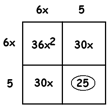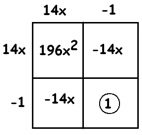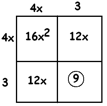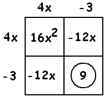The Astounding Power of Area
3.4 Level 5 Quadratics = All of Them!
[This material appears in Section 2 of the full course on Quadratics.]
Here we go! Level 5 quadratics.
EXAMPLE: Solve \(3x^{2}+5x+1=9\).
Answer: This is the first example we’ve encountered with a first term more complicated than just \(x^{2}\). We could divided throughout by \(3\) and solve instead the equation \(x^{2} + \frac {1} {3} x + \frac {1} {3} = 3\) and use the box method – and it will work (try it!) – but we will be thick in the midst of fractions.
In the previous level we would have multiplied through by \(4\) to make the middle coefficient even. But in this problem we have leading term \(3x^{2}\) which, when multiplied by four gives \(12x^{2}\), not a natural perfect square.
Let’s try dealing with \(3x^{2}\) first and make it into a perfect square by multiplying through by \(3\).
\(9x^{2}+15x+3=27\)
The first term is \(3x \times 3x\) but the middle term is \(15x\), which has an odd coefficient. To avoid fraction, let’s also multiply through by \(4\).
\(36x^{2}+60x+12=108\)
This has kept the first term a perfect square – we have \(36x^{2}=6x \times 6x\) – and has made the second term even. It seems we are set to go!

The box shows we would like the number \(25\) to appear. Let’s add \(13\) to both sides.
\(36x^{2}+60x+25=121\)
\((6x+5)^{2}=121\)
\(6x+5=11\) or \(6x+5=-11\)
\(6x=6\) or \(6x=-16\)
\(x=1\) or \(x=-\frac{8}{3}\)
Success!
EXAMPLE: Solve \(7x^{2}-x+1=9\).
Answer: Let’s multiply through by \(7\) to make the leading term a square
\(49x^{2}-7x+7=63\)
and through by \(4\) to make the second term even (and to preserve the square)
\(196x^{2}-28x+28=252\)

Subtract \(27\) from each side and we’re good to go!
\(196x^{2}-28x+1=225\)
\((14x-1)^2=225\)
\(14x-1=15\) or \(14x-1=-15\)
\(14x=16\) or \(14x=-14\)
\(x=\frac{8}{7}\) or \(x=-1\)
EXAMPLE: Solve \(2x^{2}+3x-3=5\).
Answer: Let’s multiply through by \(2\) to make the first term a perfect square.
\(4x^{2}+6x-6=10\).
The middle term is even, so it seems we are good to go.

But we see we are dealing with fractions nonetheless. Let’s multiply through by \(4\) in any case and we’ll see the fractions are cleared away.
\(16x^{2}+24x-24=40\).

Let’s add \(33\) to each side.
\(16x^{2}+24x+9=73\)
\((4x+3)^{2}=73\)
\(4x+3=\sqrt{73}\) or \(4x+3=-\sqrt{73}\)
\(4x=-3+\sqrt{73}\) or \(4x=-3-\sqrt{73}\)
\(x=\frac {-3+\sqrt{73}} {4}\) or \(x=\frac {-3-\sqrt{73}} {4}\)
The numbers weren’t pretty, but the method is straightforward.
The previous example illustrates …
THE ULTIMATE BOX METHOD: To solve an equation of the form \(ax^{2}+bx+c=d\).
i) Multiply through by \(a\) (to make the first term a perfect square)
ii) Multiply through by\(4\) (to avoid fractions)
iii) Draw the square box
and off you go!
THE BOX METHOD WILL NEVER LET YOU DOWN! The symmetry of a square is our friend.
EXAMPLE: Solve \(-2x^{2}+3x+7=1\).
Answer: Let’s multiply through by \(-2\) and then by \(4\). That is, let’s multiply through by \(-8\).
\(16x^{2}-24x-56=-8\)

\(16x^{2}-24x+9=-8+9+56\)
\((4x-3)^{2}=57\)
\(4x-3=\pm \sqrt57\)
\(x=\frac {3 \pm \sqrt57} {4}\)
Done!
Question: Was it dangerous to use the \(\pm\) symbol here?
EXAMPLE: Solve \(11x^{2}-x+5=0\).
Answer: Let’s multiply through by \(11\)and by \(4\), that is, through by \(44\).
\(484x^{2}-44x+220=0\).

Subtracting \(219\) from both sides gives
\(484x^{2}-44x+1=-219\)
\((22x-1)^2=-219\)
But there is no number whose square is negative! The box method is telling us there is no solution to this equation!
Comment: Every example here has been crafted to have a solution, but this need not always be the case. For example:
\(x^{2}=9\) has exactly two solutions.
\(x^{2}=0\) has exactly one solution.
\(x^{2}=-9\) has no real solutions.
The box method turns every quadratic into an equation of the form:
\( (something)^{2}=A\).
If \(A\) is positive, there will be two solutions; if \(A\) is zero, there will be one solution; and if \(A\) is negative, there will be no solutions (at least in the number system we’re currently working in).
EXERCISE 1: Solve:
a) \(3x^{2}+7x+5=1\)
b) \(5x^{2}-x-18=0\)
c) \(3x^{2}+x-2=2\)
d) \(2x^{2}-3x=5\)
e) \(10x^{2}-10x=1\)
f) \(2x^{2}-3x+2=0\)
g) \(2x^{2}=9\)
h) \(4-3x^{2}=2-x\)
EXERCISE 2: OPTIONAL CHALLENGE
We solved \(3x^{2}+5x+1=9\) as our first example in this lesson, but only after rejecting two initial approaches.
i) DEAL WITH FRACTIONS:
Divide through by \(3\) and consider the equation \(x^{2} + \frac {5}{3} x+ \frac {1}{3} = 3\). Draw the box for this equation, full of fractions, and show that even with the fractions the answers \(x=1\) and \(x=-\frac{8}{3}\) emerge.
ii) DEAL WITH SQUARE ROOTS:
Think of \(3x^{2}\) as \(\sqrt3 x\times \sqrt3 x\) and draw the box for \(3x^{2}+5x+1=9\) with square roots appearing on its sides. Deal with them and follow the box method all the way through to show that the answers \(x=1\) and \(x=-\frac{8}{3}\) again emerge.
No matter what route you choose to take, the box method will not let you down!
EXERCISE 3: ANOTHER OPTIONAL CHALLENGE
Fractions and other types of numbers are unavoidable in solving quadratics with non-integer coefficients.
Solve
\(\sqrt3 x^{2}-\frac{1}{\sqrt2}x+\frac{1}{10}=0\)
by making the box method work! (Start by multiplying through by \(\sqrt3\) perhaps?)
EXERCISE 4: TRY THIS ONE FOR SURE
a) A rectangle is twice as long as it is wide. Its area is \(30\) square inches. What are the length and width of the rectangle?
b) A rectangle is four inches longer than it is wide. Its area is \(30\) square inches. What are the length and width of the rectangle?
c) A rectangle is five inches longer than its width. Its area is \(40\) square inches. What are the dimensions of the rectangle?
EXERCISE 5: Solve the following quadratic equations:
a) \(v^{2}-2v+3=27\)
b) \(z^{2} +4z=7\)
c) \( w^{2}-6w+5=0\)
d) \(\alpha^{2}-\alpha+1=\frac{7}{4}\)
Also note that \(x = (\sqrt x)^{2}\). Solve the following disguised quadratics.
e) \(x-6\sqrt x+8=0\)
f) \(x-2\sqrt x=-1\)
g) \(x+2\sqrt x-5=10\) WATCH OUT! Explain why only one answer is valid for this problem.
h) \(3\beta – 2\sqrt\beta=7\)
i) \(2u^{4}+8u^{2}-5=0\)
EXERCISE 6:
a) Show that \(2(x-4)^{2}+6\) is quadratic.
b) Solve \(2(x-4)^{2}+6=10\).
c) Consider \(y=2(x-4)^{2}+6\). What \(x\)-value gives the smallest possible value for \(y\)?
Resources
Books
Take your understanding to the next level with easy to understand books by James Tanton.
BROWSE BOOKS![]()
Guides & Solutions
Dive deeper into key topics through detailed, easy to follow guides and solution sets.
BROWSE GUIDES![]()
Donations
Consider supporting G'Day Math! with a donation, of any amount.
Your support is so much appreciated and enables the continued creation of great course content. Thanks!
Ready to Help?
Donations can be made via PayPal and major credit cards. A PayPal account is not required. Many thanks!
DONATE![]()


